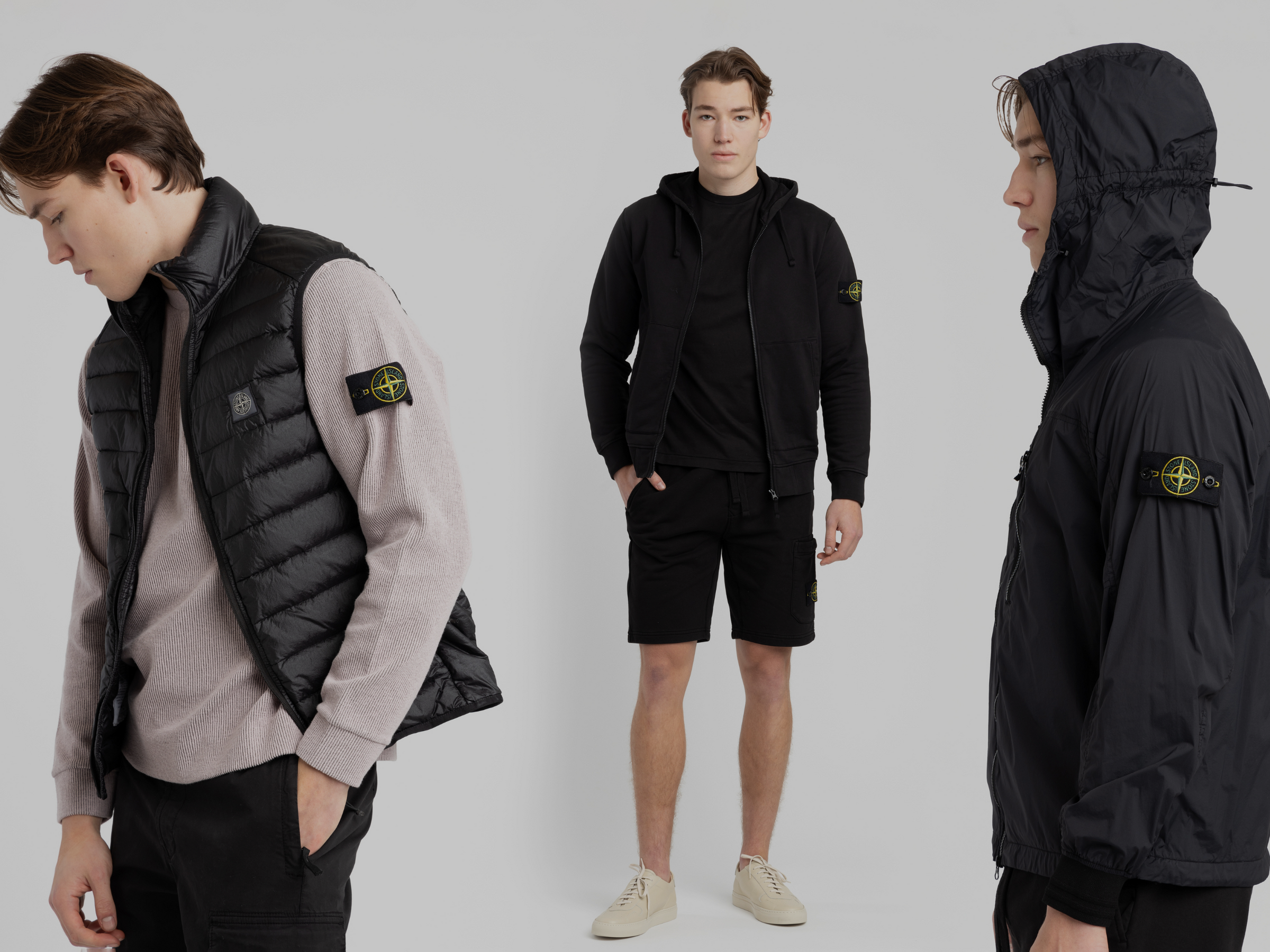
We recently had a chance to chat with the experts at Gran Sasso about their incredible knitwear.
Truly, few do it as well as Gran Sasso. They’re a staple in this industry for a reason, making over 300,000 lux sweaters, cardigans, polos, and more each year.
We’ve decided to put together some knitwear tips using their expert advice combined with some of our own tips to help you keep your knits looking their best.
What to look for in good quality knitwear
 When we talk about knitwear, we don’t only mean chunky sweaters. Knitwear encompasses everything from cardigans and roll necks to fine-knit t-shirts and polos.
When we talk about knitwear, we don’t only mean chunky sweaters. Knitwear encompasses everything from cardigans and roll necks to fine-knit t-shirts and polos.
Choosing high quality knits makes a huge difference in the longevity and overall appearance of your clothing.
The team at Gran Sasso gave us some insights into what makes their knitwear so great, so here are a few things to look for.
1. Natural materials
While there are some great technical fabrics out there, we prefer knitwear made of natural fibres like wool, silk, and cashmere.
Natural fabrics are typically more breathable and easier on the skin than synthetics, which means you can wear them on their own with less concern about smells, excess sweat, and irritation. Synthetic fibres are also more likely to pill than natural ones.
2. Long fibres

This may not always be self evident, but doing a little research on the brand you’re purchasing from first should tell you what you need to know.
Higher quality knitwear producers will spend the time to source the best natural materials, which typically results in longer and stronger fibres.
Longer fibres provide fewer opportunities for pilling, and they also result in a more durable garment.
3. High density fabric
In some cases, a loose weave is an aesthetic choice, but when you’ve got the option, opt for a tighter weave. This will help the item maintain its shape for longer and be more resistant to pilling and snagging.
This is one of the reasons we love Gran Sasso’s knitwear. They use more yarn per garment than many other knitwear producers, resulting in a fine, tight knit and a garment that will last for years.
4. Limited pre-washing
This is another aspect of quality knitwear that might take some research to find out. All knitwear goes through some sort of washing process before it hits the market, but some companies overdo it.
Lower quality knitwear is sometimes excessively pre-washed in the factory to create a soft hand. This results in more pilling and faster deterioration of the item.
Better quality knitwear producers will limit the pre-washing to ensure the garment’s longevity.
How to care for knitwear

We consulted with Gianluca Di Stefano of Gran Sasso for his top tips when it comes to caring for knitwear:
“In general, it's very important to consider label instructions: wash by hand in cold water and neutral soap, don't bleach or tumble dry but dry flat avoiding direct sunlight to prolong their wearable life.
Once clean, we advise to store knitwear in a dry ambient far from the light. It’s also important to store it in poly bags with moth-repellent inside.”
Pretty simple, right? But what if you’re not sure how to hand wash a sweater? We’ve got you covered in the next section.
(If you’re not sure what those symbols the label mean, we suggest taking a look at this article on washing instructions. )
Hand washing knitwear
You should only need to wash your knitwear a few times per season, especially if you are wearing undershirts underneath.
If it’s not smelly or stained, try not to wash it. The more you clean it, the quicker it’ll wear out.
We also suggest not taking it to the dry cleaners, unless you’ve got a major stain you just can’t get out. Dry cleaning is hard on clothing, so it’ll just wear out your knitwear faster than it needs to.
Here’s how to hand wash your knitwear:
- Fill a large sink or tub with cool water. Add a small amount of gentle detergent, like Woolite Darks or even baby shampoo, while the water is running to get the sudsy effect. About ¼ of an inch of detergent in the cup should be plenty.
- Do up any buttons or zippers before washing to help maintain the item’s shape.
- Soak the item (one at a time) in the tub, and swish it around a bit, taking care not to use too much force or stretch the fabric. Allow it to sit in the soapy water for a few minutes.
- Drain the dirty water and refill the tub with clean water. Swish it around again carefully to rinse the soap from the item. Repeat until all soap residue is gone.
Drying knitwear
“Dry flat” seems straightforward, but if you get to the drying stage and can’t quite figure out what to do next, here are our tips:
- After rinsing in fresh water, fold the clean, wet item once or twice and gently press it to remove excess water, but do not wring it out! Wringing can stretch and misshape the item. You aren’t looking to dry it completely here.
- Lay the item flat on a clean towel, and carefully roll it up to soak up the water. You may want to press on the rolled sweater a few times to get the last few drips out, but again, do not wring it!
- Unroll the sweater, and lay it flat on a drying rack away from the sun, taking care to re-shape it as best you can without stretching it. It will likely take 8-12 hours to dry, depending on the humidity in your home.
Storing knitwear

Never hang knitwear. You’ll stretch it out and distort the shoulders. Fold your knitwear and store it in a drawer or shelf away from light.
If you’re packing your knitwear away for the season, put the CLEAN and folded garment in a garment bag and store it away from light and moisture.
If you live in an area where moths could be an issue, be sure to add cedar or another moth repellant to the bag before putting it away.
If you’ve got wrinkles once you pull your sweater out from storage, avoid the urge to iron. The direct heat of an iron can damage the fibres of your sweater, so grab your steamer instead. Steaming will also fluff up the fibres, bringing a little extra life into your knitwear.
How to handle pilling
“Pilling” is the accumulation of little balls of fabric that appear on knitwear, usually around the underarms or other areas that see lots of wear. Whether it’s rubbing up against your chair at work or against other clothes in your washing machine, the more friction the item sees, the more pilling you’re likely to encounter.
Pilling is more likely to happen on looser knits (like a chunky sweater), but with time, most knit garments will pill. Not to worry, though! Here’s how to avoid and remove pilling.
1. Buy high quality garments
We mentioned this up above, but the higher quality your knitwear, the less pilling you’ll encounter. Low quality sweaters can look tattered after just a few wears because of pilling.
2. Don’t wash it too much
Because pilling is a result of friction, the more you wash a sweater, the quicker it will occur. This is also why washing it by hand, rather than in the machine, is ideal.
As we mentioned above, try not to wash your knitwear unless it’s smelly or dirty, and be gentle as you are washing it.
3. Remove lint regularly
Use a lint roller on the garment each time you wear it, which will help remove extra broken fibres that contribute to pilling.
4. Use the right tools
A fine knit cardigan needs a different approach to pill removal than a chunky sweater.
For finer knits, use a sweater comb or a new disposable razor. Pull the fabric taught and be extra careful not to snag or tear the fabric. Use small, light strokes upwards to avoid damage. If using a razor, don’t use one with the soap/moisture strips along the edge.
For chunkier knits and fleeces, a sweater stone is great. Very gently rub the stone against the fabric and remove the pills as they come off.
Use a lint roller or tape to remove the loose pills as you go.
5. De-pill regularly
Basic maintenance can keep the pilling under control. Use a sweater stone or comb to remove pilling at first sight to avoid having to do major maintenance down the road.
---
It may seem like a lot to remember, but choosing the right brands and caring for your knitwear properly will ensure you get the best life out of each item you buy. More questions about knitwear? Feel free to reach out!



